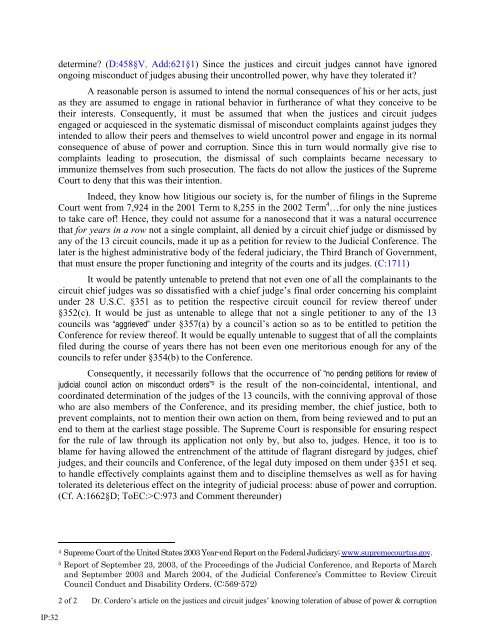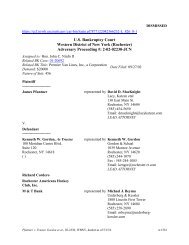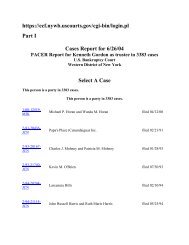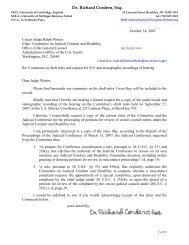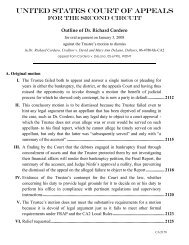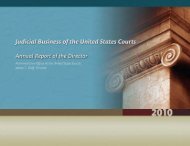Dr. Richard Cordero, Esq. Synopsis of an Investigative Journalism ...
Dr. Richard Cordero, Esq. Synopsis of an Investigative Journalism ...
Dr. Richard Cordero, Esq. Synopsis of an Investigative Journalism ...
You also want an ePaper? Increase the reach of your titles
YUMPU automatically turns print PDFs into web optimized ePapers that Google loves.
determine? (D:458§V, Add:621§1) Since the justices <strong>an</strong>d circuit judges c<strong>an</strong>not have ignored<br />
ongoing misconduct <strong>of</strong> judges abusing their uncontrolled power, why have they tolerated it?<br />
A reasonable person is assumed to intend the normal consequences <strong>of</strong> his or her acts, just<br />
as they are assumed to engage in rational behavior in further<strong>an</strong>ce <strong>of</strong> what they conceive to be<br />
their interests. Consequently, it must be assumed that when the justices <strong>an</strong>d circuit judges<br />
engaged or acquiesced in the systematic dismissal <strong>of</strong> misconduct complaints against judges they<br />
intended to allow their peers <strong>an</strong>d themselves to wield uncontrol power <strong>an</strong>d engage in its normal<br />
consequence <strong>of</strong> abuse <strong>of</strong> power <strong>an</strong>d corruption. Since this in turn would normally give rise to<br />
complaints leading to prosecution, the dismissal <strong>of</strong> such complaints became necessary to<br />
immunize themselves from such prosecution. The facts do not allow the justices <strong>of</strong> the Supreme<br />
Court to deny that this was their intention.<br />
Indeed, they know how litigious our society is, for the number <strong>of</strong> filings in the Supreme<br />
Court went from 7,924 in the 2001 Term to 8,255 in the 2002 Term 4 …for only the nine justices<br />
to take care <strong>of</strong>! Hence, they could not assume for a n<strong>an</strong>osecond that it was a natural occurrence<br />
that for years in a row not a single complaint, all denied by a circuit chief judge or dismissed by<br />
<strong>an</strong>y <strong>of</strong> the 13 circuit councils, made it up as a petition for review to the Judicial Conference. The<br />
later is the highest administrative body <strong>of</strong> the federal judiciary, the Third Br<strong>an</strong>ch <strong>of</strong> Government,<br />
that must ensure the proper functioning <strong>an</strong>d integrity <strong>of</strong> the courts <strong>an</strong>d its judges. (C:1711)<br />
It would be patently untenable to pretend that not even one <strong>of</strong> all the complain<strong>an</strong>ts to the<br />
circuit chief judges was so dissatisfied with a chief judge’s final order concerning his complaint<br />
under 28 U.S.C. §351 as to petition the respective circuit council for review there<strong>of</strong> under<br />
§352(c). It would be just as untenable to allege that not a single petitioner to <strong>an</strong>y <strong>of</strong> the 13<br />
councils was “aggrieved” under §357(a) by a council’s action so as to be entitled to petition the<br />
Conference for review there<strong>of</strong>. It would be equally untenable to suggest that <strong>of</strong> all the complaints<br />
filed during the course <strong>of</strong> years there has not been even one meritorious enough for <strong>an</strong>y <strong>of</strong> the<br />
councils to refer under §354(b) to the Conference.<br />
Consequently, it necessarily follows that the occurrence <strong>of</strong> “no pending petitions for review <strong>of</strong><br />
judicial council action on misconduct orders” 5 is the result <strong>of</strong> the non-coincidental, intentional, <strong>an</strong>d<br />
coordinated determination <strong>of</strong> the judges <strong>of</strong> the 13 councils, with the conniving approval <strong>of</strong> those<br />
who are also members <strong>of</strong> the Conference, <strong>an</strong>d its presiding member, the chief justice, both to<br />
prevent complaints, not to mention their own action on them, from being reviewed <strong>an</strong>d to put <strong>an</strong><br />
end to them at the earliest stage possible. The Supreme Court is responsible for ensuring respect<br />
for the rule <strong>of</strong> law through its application not only by, but also to, judges. Hence, it too is to<br />
blame for having allowed the entrenchment <strong>of</strong> the attitude <strong>of</strong> flagr<strong>an</strong>t disregard by judges, chief<br />
judges, <strong>an</strong>d their councils <strong>an</strong>d Conference, <strong>of</strong> the legal duty imposed on them under §351 et seq.<br />
to h<strong>an</strong>dle effectively complaints against them <strong>an</strong>d to discipline themselves as well as for having<br />
tolerated its deleterious effect on the integrity <strong>of</strong> judicial process: abuse <strong>of</strong> power <strong>an</strong>d corruption.<br />
(Cf. A:1662§D; ToEC:>C:973 <strong>an</strong>d Comment thereunder)<br />
4 Supreme Court <strong>of</strong> the United States 2003 Year-end Report on the Federal Judiciary; www.supremecourtus.gov.<br />
5 Report <strong>of</strong> September 23, 2003, <strong>of</strong> the Proceedings <strong>of</strong> the Judicial Conference, <strong>an</strong>d Reports <strong>of</strong> March<br />
<strong>an</strong>d September 2003 <strong>an</strong>d March 2004, <strong>of</strong> the Judicial Conference’s Committee to Review Circuit<br />
Council Conduct <strong>an</strong>d Disability Orders. (C:569-572)<br />
2 <strong>of</strong> 2 <strong>Dr</strong>. <strong>Cordero</strong>’s article on the justices <strong>an</strong>d circuit judges’ knowing toleration <strong>of</strong> abuse <strong>of</strong> power & corruption


